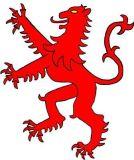 |
|
|
|
| Author |
Message |
Stuart
|
 Posted: Sun Aug 19, 2007 6:56 pm Posted: Sun Aug 19, 2007 6:56 pm |
 |
|
I can`t see why anybody would want to " rediscover" any aspect of shield combat use. Most re-enactors have a considerable knowledge base, and the way forward is to consult them first. Anything less would be re-inventing the wheel. ...
It is worth noting that the UK Norse Film & Pagant Society tried all possible variations of mass shield formations in the 1970`s.
This was done under the supervision of historians. The knowledge gained from the "Blackheath" experiments became the re-enactment standard for anyone using a shield for the next 30 years. At the time we also ran demos to film companies, martial arts groups and the TV industry.
My point here is that this knowledge was never allowed to die out.
All you have to do is ask for it and it will be freely given.
It doesn`t matter if you call it re-enactment or WMA, the technique of forming and using a shield-wall is the same.
Regards,
Stuart.
The Norse Film & Pagant Society were firstly fighters. at that time ( 1970s & 80s ) it was a warrior society.
_________________
A Dane Axe beats two aces anytime. |
|
|
 |
Colin

Location: Wellington
|
 Posted: Sun Aug 19, 2007 8:09 pm Posted: Sun Aug 19, 2007 8:09 pm |
 |
|
Where can this information be found? It is absent from anything I've seen in NZ (aside from the NZ Police).
_________________
The person who writes for fools is always sure of a large audience.
- Arthur Schopenhauer
See http://www.swordsmanship.co.nz/ |
|
|
 |
Stuart
|
 Posted: Sun Aug 19, 2007 8:23 pm Posted: Sun Aug 19, 2007 8:23 pm |
 |
|
Well, you could ask me. I was there in the 1970s.
I now live in Auckland.
How many people do you want to train ?
Regards,
Stuart.
_________________
A Dane Axe beats two aces anytime. |
|
|
 |
Colin

Location: Wellington
|
 Posted: Mon Aug 20, 2007 7:57 pm Posted: Mon Aug 20, 2007 7:57 pm |
 |
|
Topic drifting away from WMA...
I would like to know how these 70s experiments compared to the descriptions given by such military historians as Verbruggen.
I've not seen any group follow what I've read, but then I'm not too up to the play of what happens in Europe. What I've seen on YouTube et al doesn't indicate anything like it.
_________________
The person who writes for fools is always sure of a large audience.
- Arthur Schopenhauer
See http://www.swordsmanship.co.nz/ |
|
|
 |
Victorius
Location: IMPERIVM ROMANA: The Roman club with a Living History focus.New Roman Club
|
 Posted: Mon Aug 20, 2007 10:16 pm Posted: Mon Aug 20, 2007 10:16 pm |
 |
|
| Victorius wrote: | | The Dura Europas shield was about 5mm thick, and other extand fragments are not much thicker. Rounded bronze edging survives for sheilds that cannot have been any more than 8-10mm thick (although this was only for edging: no account can be given for whether they were thicker towards the centre). |
More info: Only two extant shield findings from the Roman period, plus more fragments. The first, a laminated plywood Republican oval from Faiyum in Egypt was 8-10mm thick, the "traditonal" curved tile-shaped laminated plywood Dura Europas shield (the "tpyical" Roman shield as seen on Trajan's Column and familiar to everyone), was 5mm at the edges, but thickened to 50mm (that's TWO inches) thick near the centre. Fragments from other shields at Dura, flat ones this time, are about 8-10mm in thckness, made from wooden planks, not laminated ply.
So, a range of thicknesses. Interestingly, the 5mm - 50mm tile shield is the type commonly reconstructed by Roman groups throughout the world, but they tend to go only for a uniform thickness, not the variance shown with the original.
But that was not all: the tile shield was reinforced with six iron bars between the laminated layers, adding a lot more reinforcement. This would protect against a deep cut, and in the case of a stabbing penetration by, say, a thrown spear, would maintain the integrity of the ply and prevent it further splitting than would be the case without such reinforcement.
_________________
VICTORIVS, BA.MA.HONS.I, IMPERIVM. ROMANA |
|
|
 |
Victorius
Location: IMPERIVM ROMANA: The Roman club with a Living History focus.New Roman Club
|
 Posted: Mon Aug 20, 2007 10:45 pm Re: Deflection over absorbtion Posted: Mon Aug 20, 2007 10:45 pm Re: Deflection over absorbtion |
 |
|
| Joel of Old wrote: | So how would deflection be used during a line battle? Would you deflect, trap and allow your fellow soldiers to kill your opponent? I thought that the strength of shield walls lay in the flattened shields facing the enemy, with no way through.
I agree that deflection is the way to go - the advantages are numerous, but I'm curious as to the dynamics of it during a mass combat.
Joel of Old |
The strength lay more in the formation of the combatants and their ability to stand their ground. Shields would have been part of their initial defences, but it was the combined effort of their weapons that made the difference. But there was a way through...
The Ancient Greek phalanx had overlapping shields, and the whole unit charged at full sprint with a crash into their opponents, like a cross between a rugby scrum and American Grid-Iron players charging at one another. This full-one in-your-face combat meant that one had no room to deploy their hand-held spears at enough range to be useful, so they tended not to try to bash or get between shields as they had no room to swing them to any great effect, or draw back their arms, so they stabbed viciously over the top (hence the need for those almost full-face Corinthian helmets the later Italians were to copy with their barbutes) or underneath to get a groin wound, if they could. That only left the legs, hence heavy greaves.
About the only thing to defeat the traditional phalanx was the later Macedonian phalanx, which had a looser formation, a frontage per man of about 1 metre. They carried their shields suspended over the shoulder, and deployed two-handed 7 metre pikes. This formation kept the older phalanx at bay in a holding action, allowing cavalry units to outflank them. Unless either phalanx collapsed, or was outflanked (and remember, 300 Spartans kept an army of 100,000 at bay until they were attacked from behind, and that, and only that, was what took them down), there might oly be a dozen casualties on each side (out of a phalanx of about 6000).
The Macedonain phalanx in turn was defeated by the more flexible Roman legionary formation, which used uneven ground to its advantage. They could maintain unit integrity while crossing rough terrain, whereas the Macedonian phalanx would end up with gaps in their frontage, which the Romans would exploit. They tended not to take the phalanx on front-on however, not unless the line was broken. When they did, they would catch pikes on their bosses, turning them aside with their shields (ie, NOT by absorbing them), and use their swords to knock the more unwieldy pikes aside. The Romans fought with a more open formation, with enough room for forward ranks to retreat down the lines between each file. When they fought closed formation, their shields tended not to overlap.
But they needed iron reinforcing bars to strengthen their shields. sometimes this was not enough: during the Dacian campains of Trajan (as shown in the famous column, and the less-known Adamklissi Tropaeum), they faced opponents wielding a long two-handed weapon called a falx, kinf of like a reverse Japanese sword. This weapon could cut right through Roman shields - the iron reinforcing was not enough, and they had to come up with reinforced helmets, and full-plate arm armour, as well as various leather or linen armour.
So, basically, the ancient shield wall relied less on the use of shields to absorb blows, but rather to act as a temporary frontage while their weapons did all the work.
_________________
VICTORIVS, BA.MA.HONS.I, IMPERIVM. ROMANA |
|
|
 |
White Knight

Location: Orcland
|
 Posted: Wed Sep 05, 2007 10:24 pm Posted: Wed Sep 05, 2007 10:24 pm |
 |
|
I remember in the days of Comitatus while training with Colin we were practising shield formation with kite shields. Three people stood with their shields overlapping. I voluntereed to test the strength of this shield wall.
I was holding a kite shield and charged them at full speed and literally did a flying leap straight at them. I hit them square on and they didn't move back, not even an inch. Their shield wall didn't buckle and there was no way that I could break through. And believe me I hit hard with every intention of trying to break through.
Remember there was only 3 of them it was not as if i was hitting a shield wall consisting of a 100 guys or so.
The reason why their wall held was because of correct technique in how they overlapped their shields and because of this the force of my impact was distributed evenly between all three shields not just the one in the middle which I hit.
When shields in a shield wall overlap they don't have to deflect a hit as they are capable of absorbing the hit and distributing it evenly among the nearby shields.
It would be almost impossible to move your shield to turn aside a hit as it would be locked in place by the other overlapping shields. You could possibly raise or lower it but that would be about it.
A strong shield can better absorb a hit.
A thin shield would best be used to deflect a hit rather than trying to absorb it. This sort of tactic would best work in loose melee fighting not in a tight shield wall formation.
Curved shields better deflect hits than flat ones.
_________________
Living History. Choose to be part of it. |
|
|
 |
Carl

Location: Just beyond the firelight
|
 Posted: Wed Sep 05, 2007 10:33 pm Posted: Wed Sep 05, 2007 10:33 pm |
 |
|
we would practice that kind of shield wall at Sword and Shield, Steve enjoyed using to demonstrate how effective shields were to novices or juniors.
I rememeber when the journalists who wrote the article on AS&SS for METRO magazine came to the club we stuck him in the middle of the shield wall and had Big Mac charge it, now Big Mac can put a fair amount of energy into a charge and he hits like the poverbial when he is at full noise, and this journo was rather white faced as he charged at him.
but after the shield he was holding Broke before the shield wall collapsed he was suitably impressed.
Steve almost wet himself laughing 
_________________
It is not enough to say I will not be evil. Evil must be fought wherever it is found |
|
|
 |
Vorschlag

Location: Auckland
|
 Posted: Wed Sep 05, 2007 11:03 pm Posted: Wed Sep 05, 2007 11:03 pm |
 |
|
| Quote: | | A strong shield can better absorb a hit. |
Your suggesting in a shield wall correct?, your not actually suggesting people attempt to block an actual blow with a shield are you?, surely you can't have forgotten the lessons with Colin already.
_________________
On five words hinge the entire art of the sword, in and out of armour, on horse and on foot. |
|
|
 |
conal
Site Admin
|
 Posted: Wed Sep 05, 2007 11:57 pm Posted: Wed Sep 05, 2007 11:57 pm |
 |
|
| I hit a couple of very well formed walls at Taupo a couple of years back and technique had alot to do with the way they pasted me. |
|
|
 |
conal
Site Admin
|
 Posted: Thu Sep 06, 2007 12:23 am Posted: Thu Sep 06, 2007 12:23 am |
 |
|
Hey Victor.
That stuff on the structure of the (Scutum?) shield was cool.
One assumes then the legionaire armoured his left side as he was able?
So few finds but at least a good spectrum in terms of a style.
In the way the sheild overlapped & the body positioned they could convey the force liquidly down the shieldwall face?
This coupled with the discipline of empire two pilum and a gladius if your were lucky.
"Romans, what'd they ever do for us?"
I love plywood. |
|
|
 |
Victorius
Location: IMPERIVM ROMANA: The Roman club with a Living History focus.New Roman Club
|
 Posted: Thu Sep 06, 2007 8:29 pm Posted: Thu Sep 06, 2007 8:29 pm |
 |
|
| T.M.M wrote: | | Quote: | | A strong shield can better absorb a hit. |
Your suggesting in a shield wall correct?, your not actually suggesting people attempt to block an actual blow with a shield are you?, surely you can't have forgotten the lessons with Colin already. |
Bouncing off modern shieldwalls while deploying blunt steel may seem the way to go, and for what we do, it probably is...but let's not forget (and I mentioned it in one of the other shield posts), that a weapon used with enough force CAN penetrate a shield. There's a photograph on the net from one of the overseas Roman groups with one of their shields in a jig, while a guy chops a sharp falx into it. Shears it about a third of the way down. Furthermore, there's my own experience at Taupo two years ago, when someone with a BLUNT re-enactment spear thrust the whole head right through my shield just above the boss. Just a few centimetres lower and I'd have sustained serious damage to my wrist (not a weak shield either: 12mm laminetd ply, strengthened with woodglue, covered with a layer of glued 2mm leather, and a layer of glued linen on top of that).
_________________
VICTORIVS, BA.MA.HONS.I, IMPERIVM. ROMANA |
|
|
 |
Victorius
Location: IMPERIVM ROMANA: The Roman club with a Living History focus.New Roman Club
|
 Posted: Thu Sep 06, 2007 8:39 pm Posted: Thu Sep 06, 2007 8:39 pm |
 |
|
Hi Conal,
Yes, they armoured themselves more often than not. Maille first, then plate segmentata, then finally back to maille again.
Their sheild wall was more liquid up until about the Second Centruy AD, after that they began overlapping shields to form tight formations, though this was more to resist armoured cataphrapt cavalry than infantry.
From what we can tell, they seem to have moved their shields about a bit: the Adamklissi Tropaeum shows heavily armoured legionaries shoving their shields into the faces of their opponents before the latter can deploy their falxes to any great effect.
Gladiators who used the big legionary scuta are sometimes shown crouching down behind them, held straight up and down, but more often than not, they are shown holding them angled bottoms outwards, as if they want to deflect, rather than absorb, incoming strikes.
_________________
VICTORIVS, BA.MA.HONS.I, IMPERIVM. ROMANA |
|
|
 |
White Knight

Location: Orcland
|
 Posted: Tue Sep 11, 2007 11:08 pm Posted: Tue Sep 11, 2007 11:08 pm |
 |
|
I wasn't suggesting that someone should use a shield to absorb a blow I was merely making a comparison between two schools of thought.
If a re-enactor intends to use his shield for blocking (not recommended) he will make a stronger shield than the person who makes a shield for the intention of using it to deflect a blow.
_________________
Living History. Choose to be part of it. |
|
|
 |
|
|
 Please read the terms of use
Please read the terms of use
 Contact the Site Admin
Contact the Site Admin

